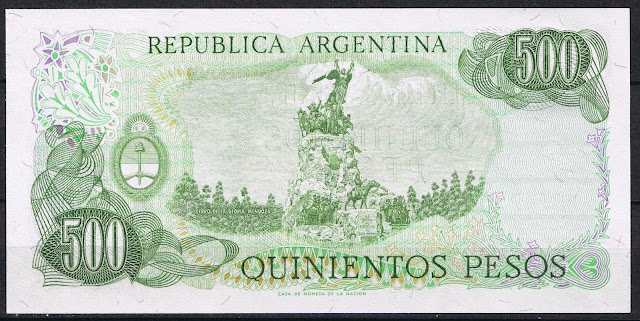Argentina Banknotes 500 Pesos banknote 1980 General Jose de San Martin
Central Bank of Argentina - Banco Central de la República Argentina
Obverse: Portrait of General Don Jose de San Martin (1778 – 1850), known simply as José de San Martín, was an Argentine general and the prime leader of the southern part of South America's successful struggle for independence from the Spanish Empire.
Reverse: Monument to the Army of the Andes, which is located at Cerro de la Gloria, inside the General San Martín Park, in the city of Mendoza. Coat of arms of Argentina at left.
Watermark: Coat of arms of Argentina.
Printer: Casa de Moneda de la Nación, Buenos Aires, Argentina.
Original Size: 154 x 75 mm.
Argentina Banknotes - Argentina paper money
1970-1983
500 Pesos 1000 Pesos 5000 Pesos 10000 Pesos
Monument to the Army of the Andes
The Andes Army Monument, which is located at Cerro de la Gloria, inside the General San Martín Park, in the city of Mendoza. On top of the monument there is a group of grenadiers throwing themselves into battle. Liberty, with broken chains around her hands, advances over the group. Further down, a condor about to fly off symbolizes the inspiration behind the heroic deed. The Argentine Coat of Arms appears under the fraying group; in the eastern wall is the Peruvian Coat of Arms, and in the western wall, the Chilean one. On the front, detached from the whole and over a stone base, General San Martín's equestrian statue stands out. On the background and to both sides, two reliefs represent the Mounted Grenadiers Corps. On the eastern, southern, and western sides, three carved friezes attached to the base evoke the most remarkable facts about the creation of the army.
The monument is the work of Uruguayan sculptor Juan Manuel Ferrari (1874–1916). Juan Carlos Oliva Navarro (1888–1951) and Víctor Garino (1878–1958), among others, helped build it. It was began in 1911, as part of the celebrations of the Argentina Centennial of 1910. The monument is unveiled on February 12, 1914, the date of the 97th anniversary of the Battle of Chacabuco.
Army of the Andes
The Army of the Andes was a military force created by the United Provinces of the Río de la Plata (Argentina) and mustered by general José de San Martín in his campaign to free Chile from the Spanish Empire. In 1817, it crossed the Andes Mountains from the Argentinian province of Cuyo (his staging point being the current-day province of Mendoza, Argentina), and succeeded in its objective by dislodging the Spanish from the country.
The exact number of the army varies between different sources; some have put the number as low as 3500, while others have it being as high as 6000 men. The army consisted of Argentinians and Chileans, and included some 1200 auxiliaries to help in provisioning and supply, as well as a complement of artillery. The Congress of Tucumán endorsed San Martín's proposal to form an army to fight the royalists in Chile, and between August 1814 and February 1817, San Martín trained his troops to prepare them for their ordeal. While the army was made up of a less than experienced military force, San Martín intended to lead, with regular discipline and equipment, a proper army and not a "motley crew" into battle.
For the crossing of the mountains, the Army was divided into two main columns, the first, commanded by Captain General San Martín and supported by Brigadier Major Miguel Estanislao Soler and Brigadier Bernardo O'Higgins, would take the Los Patos Pass and the second, commanded by Colonel Juan Gregorio de las Heras, would take the Uspallata Pass, which at its highest reaches some twelve thousand feet above sea level. Because this second pass was more negotiable, the artillery was taken in the second column.
These two divisions were the main body of the Army, but there were smaller detachments sent to the north and south as flanking wings. The smaller division to the north was composed of some 130 infantry as well as a group of Chilean expatriates, and was under the command of Juan Manuel Cabot. To the south was a group under the command of the Chilean Ramón Freire Serrano.
After their 25-day journey across the Andes, the Army of the Andes successfully met royalist forces in the Battle of Chacabuco. After the victory, they entered Santiago de Chile, where San Martin was unanimously elected Supreme Director but by his own resolve, as well as from instructions received from Buenos Aires, the general declined. After his refusal, O'Higgins was finally elected. Under Argentinian officers, the Chilean army resurrected and San Martín was designated commander of the "United Army", which was an army that combined the forces of the Army of the Andes and Chilean troops. This new army fought the counterattack of royalist Army of Osorio at battles of Cancha Rayada and Maipú.

